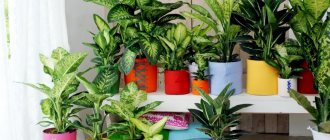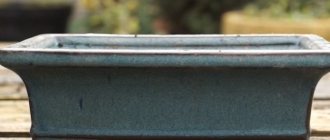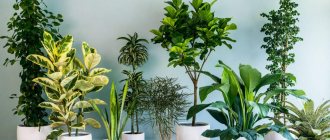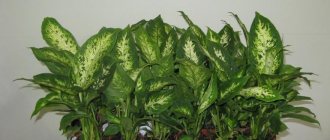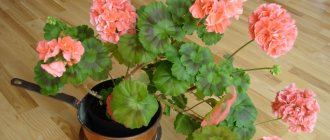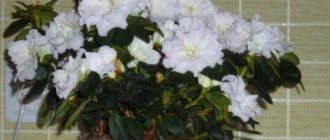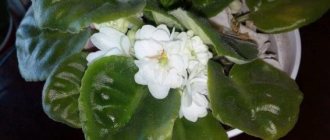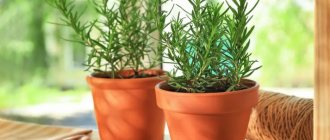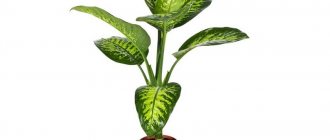A bright and attractive Dieffenbachia with luxurious striped leaves native to South America. The genus is named after the Austrian botanist Joseph Dieffenbach, who was head gardener at the Imperial Botanical Garden in Vienna in the 19th century.
All types of Dieffenbachia are evergreen plants from the Araceae family. In nature, they can grow up to 2 m, and can grow to the same size in an apartment. So you need a lot of space for this flower. The leaves are large, with spots and streaks, which gives them a special chic. But despite its beauty, Dieffenbachia can rarely be found in our apartments, because almost mystical powers are attributed to this plant. The chairman of the Moscow Flower Growers club, a collector of ornamental flowering plants, Tatyana Zhashkova, told us about the features of this plant
Types and varieties of Dieffenbachia
There are more than 60 species of Dieffenbachia in nature(1). But only a few of them are grown indoors.
Dieffenbachia seguine. In floriculture, it is better known under the old name Dieffenbachia maculata. This is one of the most popular species and the tallest - the plants reach a height of 2 m. The leaves are large, up to 50 cm long, with patterns of light specks.
There are many interesting varieties of this species.
- Green Magic - with deep green leaves with a cream vein in the center;
- Camille - it has white leaves with a green stripe along the edge;
- Compacta is a low-growing variety 50–65 cm high with light green leaves and dark green spots;
- Reflektor is a very bright variety with camouflage colored leaves: yellow and white spots are densely “scattered” on a dark green background;
- Rudolph Roehrs - with pistachio-colored leaves, a dark green stripe along the edge and a central vein of the same color, with white and green spots;
- Tropic Marianne - with cream-light green leaves with white veins and a thin dark green border;
- Tropic Sun - with light green leaves with a dark green border and central vein;
- Tropic Snow - with dark green leaves and numerous light stripes, streaks and spots;
- Tropical Tiki - with silvery leaves, on which numerous white spots are scattered, the border is dark green, and the central vein is light green.
Green Magic. Photo: YouTube
Camilla. Photo: YouTube
Reflector. Photo: YouTube
Tropical Tiki. Photo: YouTube
leopoldii . This species is native to Costa Rica. The plant is short, the trunk does not exceed 5 cm in height, but the leaves are long - up to 35 cm. They are dark green, with a white central vein. The petioles are short, about 15 cm, pale green with purple splashes.
Dieffenbachia oerstedii. Tall species up to 1.8 m high. Leaves up to 35 cm long, glossy, dark green, with a white vein in the center and sparse spots along it.
macrophylla . The species is native to Peru. The stem is up to 1 m high, the leaves are large, up to 60 cm long, rich green in color and have lighter veins. The juice has an unpleasant specific smell.
Dieffenbachia bausei. The plant is up to 90 cm high. The leaves are medium-sized, up to 30 cm long, oval, light green in color with a white marble pattern.
Dieffenbachia Estreda. Photo: YouTube
Dieffenbachia Bauze. Photo: YouTube
Botanical description
Dieffenbachia belongs to the Araceae family and is an evergreen plant growing in the tropical zone of South America.
Distinctive features:
- has juicy thick stems topped with large leaves of variegated colors;
- the height of an adult bush can reach 2 meters;
- flowering indoors is a rather rare occurrence, but in nature the crop blooms in April-May;
- the inflorescence is a spadix located on a green-cream blanket;
- after flowering, red or orange berries form in place of the cob;
- the culture is fast growing;
- the leaves of the plant perform a decorative function; their color is very diverse - they can be decorated with dashes, spots or stripes, depending on the variety.
The flower is named after the Australian gardener Joseph Dieffenbach at the Imperial Botanical Garden at Schönbrunn Palace in Vienna. According to folk superstitions, it is also called the “widow’s flower.” It is believed that Dieffenbachia absorbs male energy, thereby destroying family ties.
In the photo below you can see Dieffenbachia blooming, a rather rare occurrence.
Caring for Dieffenbachia at home
Dieffenbachia is quickly becoming a favorite because it looks very impressive and is also extremely unpretentious. But some features of agricultural technology still need to be taken into account.
Priming
Dieffenbachias come from tropical forests, and there is a lot of organic matter in the soils there. Therefore, the soil for them must be fertile. Purchased soil is suitable for decorative foliage plants.
But it’s better to cook it yourself. The best option is a mixture of leaf soil, humus, peat and sand in a ratio of 3:1:1:1 (2).
Temperature
These plants do not have a pronounced dormant period, so they need to be grown in a warm place throughout the year. The optimal temperature is 20 – 25 °C; in winter it should not fall below 17 °C. Dieffenbachia does not tolerate drafts and temperature changes.
Lighting
Dieffenbachias do not tolerate bright sun, much less direct sunlight - they need shade. Moreover, they can easily be tolerated even with minimal lighting - they can be grown in the back of the room. However, in winter it is useful to place it on the windowsill (3) - at this time the sun is inactive and harmless, and away from the window it becomes too dark.
Humidity
The plant loves abundant watering (in spring and summer once every 2-3 days, in autumn and winter - once every 4-5 days), but does not tolerate excess moisture, so the pot definitely needs drainage.
Fertilizers and fertilizers
It is useful to feed Dieffenbachia once every 2 weeks from March to September - this is when they actively grow. It is best to use a complex liquid fertilizer. But it is important that it does not contain a lot of nitrogen (2) - it causes plants to grow very quickly.
Trimming
As Dieffenbachia grows, it often sheds its lower leaves, exposing the trunk - this is their natural feature. However, the plants lose their decorative properties. In order for the bushes to be lush, they need to cut off the tops once a year - then the dormant buds on the stems will wake up and new young shoots will appear.
Features of transplantation
How to grow Dieffenbachia? In addition to basic care, do not forget to periodically replant it. Young plants require an annual change of “place of residence,” while adult specimens only need to be moved once every two years. It is best to arrange a transplant at the end of February or beginning of March.
To do this, choose a pot 1-2 cm larger than the previous one. In a pot that is too large, the soil may oxidize, and the plant itself will be too active in forming roots.
Reproduction of Dieffenbachia at home
Photo: YouTube
Dieffenbachias reproduce well vegetatively and there are 2 methods that give excellent results.
Apical cuttings. In this case, cut off the top of the plant, tear off the lower leaves, if any, and plant the cuttings in a mixture of sand and sphagnum moss in equal proportions (2).
Stem pieces. It is better to root them in a mixture of sand and soil, also in equal proportions (2). Each piece should have 2–3 internodes. The stem sections are laid horizontally on the ground and covered with film or glass.
Both propagation options give best results in summer and late December. Cutting cuttings and pieces of stems is best combined with pruning the plant.
Watering mode
The large foliage of Dieffenbachia intensively evaporates moisture. And to replenish it, you need to regularly water the plant. On average, Dieffenbachia should be watered 2-3 times a week in summer and about 1-2 times in winter.
Just remember: both drought and excess water will negatively affect the condition of the plant. So it needs to be provided with moderate humidity. You can determine the need for the next watering by the condition of the soil: its top layer should dry out by about a third.
Do not forget to pour out any excess water that has accumulated in the pan. Otherwise, the roots of Dieffenbachia may rot.
Dieffenbachia diseases
Photo: YouTube
Problems with Dieffenbachia usually occur due to improper care.
The stem rots. This often happens if the plant is overwatered or the room is cool - the temperature is below 17 °C.
At the initial stage, when only part of the shoot is affected, the diseased tissue can be cut out with a sharp knife and the wound can be sprinkled with crushed charcoal. If the stem is severely rotten, you need to cut off and root the healthy top, and throw away the rest.
Leaves become pale. This happens if the plant is in too bright a room or if direct sunlight falls on it.
Move the Dieffenbachia to a darker place and the color of the leaves will soon be restored.
Young leaves fall. There are three reasons for this problem:
- temperature too low;
- dry air;
- drafts.
Move Dieffenbachia to a warm place and spray more often.
The edges of the leaves dry out. This occurs due to lack of watering - Dieffenbachias do not like it when the soil dries out; it should always be moist. The second possible reason is cold air.
The soil
Usually I bought ready-made earthen mixtures for the desired type of plant. But a few years ago I had to urgently plant Dieffenbachia in the soil that was at hand at that time. And although this option was considered as temporary, it turned out to be the most optimal for the plant. Unlike the previous experience, when the plant grew rather sluggishly, with the new planting option the shrub pleased us not only with larger leaves, but also sprouted new shoots twice.
So, pieces of red brick remaining after the repair were placed at the bottom of a five-liter pot. On top of them I poured expanded clay - drainage for cacti. That is, the drainage amounted to almost a third of the pot. The next layer was the remains of purchased soil for cacti (almost sand). The penultimate layer was light turf soil with a fair share of dry spruce needles. And finally, the last layer was black soil from the garden, diluted by a third with sand.
The bush, planted in the remains of different soils, took root surprisingly quickly and delighted everyone who beheld it with its appearance: the leaves became large, juicy, and shiny.
Pests of Dieffenbachia
Dieffenbachia most often affects 2 types of pests.
Spider mite. The first signs are numerous small whitish dots on the leaves. With severe infection, the leaves begin to turn yellow and fall off, and cobwebs appear on the plant.
To destroy spider mites, you can use the drug Kleschevit (4).
Shield. It usually lives on stems and on the undersides of leaves. The insects are motionless and look like small brown tubercles. With severe damage, the growth of Dieffenbachia slows down greatly, its leaves begin to dry out and eventually the plant may die.
It is difficult to fight scale insects. The first step is to manually remove all insects using a cotton pad soaked in alcohol or vodka. And then carry out 2 - 3 treatments of the plant with Actellik (4).
Why can't Dieffenbachia be kept at home?
The juice of this plant is poisonous to people and animals. If it gets on the skin, it can cause serious burns. If the juice gets into the stomach, swelling of the larynx and tongue, blurred vision, interruptions in heart function, and anaphylactic shock may occur. Therefore, it is not recommended to keep diffebanchias in apartments where there are animals and small children.
In addition to the obvious harm from the poisonous juice, the reputation of Dieffenbachia is also spoiled by the superstitions associated with it. It is believed that in ancient times, the leaf of this plant could deprive a person of speech by sealing his mouth (which is completely understandable - the poisonous juice, causing swelling of the larynx and tongue, did not give the person the opportunity to speak).
But now there is a different opinion: Dieffenbachia is called “husband,” a symbol of celibacy. It is believed that this plant weakens male energy, which is why men cannot be in the same room with it. Therefore, it is not recommended for unmarried girls to have it. By weakening male energy, Dieffenbachia allegedly makes married couples infertile.
But, of course, this is nothing more than superstition.
Popular questions and answers
Agronomist-breeder Svetlana Mikhailova told us about growing Dieffenbachia and the problems that may arise
How to choose Dieffenbachia?
Always pay attention to the appearance of the plant - there should be no stains, mechanical damage or signs of pests on the leaves. Inspect the shoots - it is important that they are not rotten.
Does Dieffenbachia bloom?
Yes, it blooms, but at home this does not happen often. And the flowers of Dieffenbachia are inconspicuous - a small cob surrounded by a green blanket.
Why do Dieffenbachia leaves turn yellow?
If the old lower leaves turn yellow and fall off, this is normal; this is a natural feature of Dieffenbachia. However, if young leaves turn yellow, then most likely the room is cool or the plant is in a draft.
Bloom
If you follow basic precautions, Dieffenbachia can and should be kept at home. It will help improve the chemical composition of indoor air, since the plant tends to neutralize the effects of toxic elements
The flower also has phytoncidal qualities and is guaranteed to reduce the number of dangerous pathogenic microbes - for example, staphylococci.
Maintaining Deffenbachia generally does not lead to its flowering. But if you create excellent conditions, you can actually observe the release of buds every summer. Externally, the flowers do not strike with particular beauty - they are cobs with small yellow-white flowers, covered with a kind of blanket, painted gray-green. After flowering ends, neither the cob nor the fruits have decorative value.
Experienced flower growers prefer to get rid of buds even when inflorescences form on them. Since the plant becomes weak, which is facilitated by its flowering. It can really be observed in April – early May. At the end of flowering, it is recommended to prune the flower so that it does not take away from the crop the microelements necessary for proper growth.
Sources
- Dieffenbachia // The Plant List (https://www.theplantlist.org/1.1/browse/A/Araceae/Dieffenbachia/)
- Visyashcheva L.V., Sokolova T.A. Industrial floriculture. Textbook for technical schools // M.: Agropromizdat, 1991 – 368 p.
- Dr. Hessayon D.G. All about indoor plants // M.: Kladez-Buks, 2002 – 256 p.
- State catalog of pesticides and agrochemicals approved for use on the territory of the Russian Federation as of July 6, 2022 // Ministry of Agriculture of the Russian Federation (https://mcx.gov.ru/ministry/departments/departament-rastenievodstva-mekhanizatsii-khimizatsii -i-zashchity-rasteniy/industry-information/info-gosudarstvennaya-usluga-po-gosudarstvennoy-registratsii-pestitsidov-i-agrokhimikatov/)
